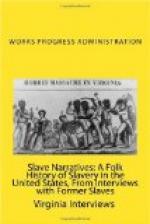Former Slave Interview, Special Aug 16, 1937
Butler County, District #2
Middletown
Mrs. Nance east 809 Seventeenth Ave., Middletown, Ohio
“Mammy” East, 809 Seventeenth Ave., Middletown, Ohio, rules a four-room bungalow in the negro district set aside by the American Rolling Mill Corporation. She lives there with her sons, workers in the mill, and keeps them an immaculate home in the manner which she was taught on a Southern plantation. Her house is furnished with modern electrical appliances and furniture, but she herself is an anachronism, a personage with no faith in modern methods of living, one who belongs in that vague period designated as “befo’ de wah.”
“I ’membahs all ’bout de slave time. I was powerful small but my mother and daddy done tole me all ’bout it. Mother and daddy bofe come from Vaginny; mother’s mama did too. She was a weaver and made all our clothes and de white folks clothes. Dat’s all she ever did; just weave and spin. Gran’mama and her chilluns was sold to the Lett fambly, two brothers from Monroe County, Alabama. Sole jist like cows, honey, right off the block, jist like cows. But they was good to they slaves.
“My mother’s last name was Lett, after the white folks, and my daddy’s name was Harris Mosley, after his master. After mother and daddy married, the Mosleys done bought her from the Letts so they could be together. They was brother-in-laws. Den I was named after Miss Nancy. Dey was Miss Nancy and Miss Hattie and two boys in the Mosleys. Land, honey, they had a big (waving her hands in the air) plantation; a whole section; and de biggest home you done ever see. We darkies had cabins. Jist as clean and nice. Them Mosleys, they had a grist mill and a gin. They like my daddy and he worked in de mill for them. Dey sure was good to us. My mother worked on de place for Miss Nancy.”
Mammy East, in a neat, voile dress and little pig-tails all over her head, is a tall, light-skinned Negro, who admits that she would much rather care for children than attend to the other duties of the little house she owns; but the white spreads on the beds and the spotless kitchen is no indication of this fact. She has a passion for the good old times when the Negroes had security with no responsibility. Her tall, statuesque appearance is in direct contrast to the present-day conception of old southern “mammmies.”
“De wah, honey? Why, when dem Yankees come through our county mother and Miss Nancy and de rest hid de hosses in de swamps and hid other things in the house, but dey got all the cattle and hogs. Killed ’em, but only took the hams. Killed all de chickens and things, too. But dey didn’t hurt the house.




